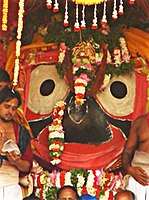Balarama Dasa
Balarama Dasa (Born c. 1474-1522) was an Odia poet and litterateur. He was one of the 5 great poets in Odia literature, the Panchasakha during the Bhakti age of literature.He was the oldest and is said to be the most talented of the Pancha sakha . He wrote the Odia Ramayana also known as Jagamohana Ramayana.[1][2]
Matta Balarama Dasa | |
|---|---|
 "Statue of Balarama Dasa at Bhanja Kalamandapa, Bhubaneswar " | |
| Born | c. 1472 Puri |
| Occupation | Poet,Ascetic |
| Language | Odia |
| Genre | Mythology,Ballads |
| Notable works | Dandi Ramayana |
Personal life
Not much is known about his early life. His father Somanath Mohapatra was a courtier of King Prataprudra Deva.[3] He was educated and was well versed in sanskrit. He became a devotee of Jagannatha. In his middle ages he came in contact with Sri Chaitanya and it is said that he was initiated into Vaishnavism by him.[4] It is speculated that he died while on a pilgrimage to Puri in begunia village near Konark. There is a memorial for him near this village.[5]
Literary works
Balaram translated the Ramayan to Odia. It is also known as Jagamohana Ramayana or Dandi Ramayana. While it is a translation , it deviates in many was from the original. In some parts he goes against the original text and in some parts follows the original text closely and yet in some other parts he creates entirely new narratives.[2][6]
He also broke new grounds by translating the Bhagabat Gita into Odia. Before this the philosophical and theological texts were not translated into Odia. Even In Odia Mahabharata by Sarala Das , the portion containing Bhagabat Gita was omitted by the author. Balarama Dasa was subsequently persecuted by the priestly class for his translation of Bhagabat Gita.[2] His other works are as below.[4][1][7]
- Laxmi Purana
- Kanta Koili
- Baramasa Koili
- Hanuman Chautisha
- Kamalalochana Chautisha
- Gupta Gita
- Vedantasara Gita
- Udhaba Gita
- Brahma Gita
- Pralambasara Gita
- Amarakosha Gita
- Brahmananda Bhugola
- Bata Abakasha
- Bedha Parikrama
- Bhaba Samudra
- Karna Dana
- Mriguni Stuti
- Virata Gita
- Saptanga Yogasara Gita
References
- Mukherjee, S. (1998). A Dictionary of Indian Literature: Beginnings-1850. A Dictionary of Indian Literature. Orient Longman. p. 35. ISBN 978-81-250-1453-9. Retrieved 2019-08-27.
- St-Pierre, P.; Kar, P.C. (2007). In Translation: Reflections, Refractions, Transformations. Benjamins translation library. John Benjamins Pub. p. 171. ISBN 978-90-272-1679-3. Retrieved 2019-08-27.
- Patnaik, H.S.; Parida, A.N. (1996). Aspects of socio-cultural life in early and medieval Orissa. DSA Programme, Post Graduate Dept. of History, Utkal University. Retrieved 2019-08-27.
- Dalal, R. (2014). Hinduism: An Alphabetical Guide. Penguin Books Limited. p. 260. ISBN 978-81-8475-277-9. Retrieved 2019-08-27.
- Dalal, R. (2014). Hinduism: An Alphabetical Guide. Penguin Books Limited. p. 261. ISBN 978-81-8475-277-9. Retrieved 2019-08-27.
- Paniker, K.A.; Sahitya Akademi (1997). Medieval Indian Literature: Surveys and selections. Medieval Indian Literature. Sahitya Akademi. p. 401. ISBN 978-81-260-0365-5. Retrieved 2019-08-27.
- ""Panchasakha"-Sri Balaram Das". ReportOdisha.com. 2015-10-28. Retrieved 2019-08-27.
